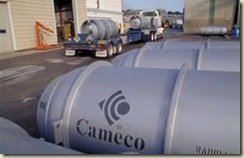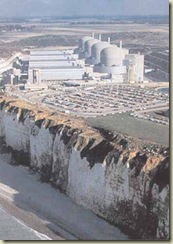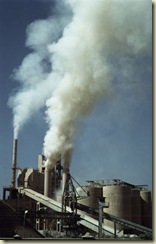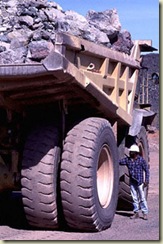There have been quite a few articles in the press from the nuclear lobby and the opposition party touting the climate change benefits of Nuclear Power. Besides the harmful nuclear waste that the process leaves behind, the claim that nuclear power generation is CO2 free is simply a myth. In my search to find proof, I stumbled upon this great post. I cannot claim the words in this post. They belong to Dave Kimble from http://www.peakoil.org.au/ and they are wise and well researched words as well.
Proponents of nuclear power always say that one of the big benefits of nuclear power is that it produces no Carbon dioxide (CO2).
This is completely untrue, as a moment’s consideration will demonstrate that fossil fuels, especially oil in the form of gasoline and diesel, are essential to every stage of the nuclear cycle, and CO2 is given off whenever these are used.
![clip_image002[4]](https://www.greeningofgavin.com/wp-content/uploads/2009/08/clip_image0024.jpg)
This is Ranger Uranium Mine’s Pit Number 1.
All of the material removed from this hole, over-burden and ore, was moved by truck.
 |
The depleted ore is washed and neutralised using lime, and the slurry is pumped to the tailings ponds. |
 |
Maintaining the tailings ponds, with more diesel powered machinery. |
 |
Hard rock ores, such as quartz conglomerates and granites, are approximately 3 to 4 times more energy-intensive than soft rock ores (limestones and shales) to crush. |
 |
Drums of Uranium oxide are stacked by forklifts, while they await shipment, sometimes to the other side of the world. |
 |
The Uranium hexafluoride gas is then transported in cylinders to be enriched. |
 |
The standard enrichment process for pressurised water reactor (PWR) fuel converts this mix to: |
 |
Low-enriched (3.6%) Uranium hexafluoride gas is then transported to the fuel fabrication plant. |
 |
The UF6 gas is converted to Uranium dioxide (UO2) powder, pressed into pellets, and baked in an oil-fired furnace to form a ceramic material. These are then loaded into a tube made of a zirconium alloy. Several of these tubes form one fuel assembly. |
| Zirconium is a metallic element derived from zircon, an ore of Zirconium silicate (ZrSiO4), which is a by-product of rutile sand mining (another energy-intensive business). Naturally occurring Zirconium is always found with Hafnium, which has to be removed (with difficulty) for nuclear uses. For every tonne of Uranium in the fuel, up to 2 tonnes of Zirconium alloy are needed. |
 |
 |
Fresh fuel is only mildly radioactive and can be handled without shielding. The fuel assemblies are then transported to the reactor by truck or train. A 1000 MW(e) nuclear reactor contains about 100 – 130 tonnes of Uranium dioxide, and usually one third of that is replaced in rotation each year. |
 |
If you ignore the vehicles that the workers use to get to work, the reactor does not produce any CO2. But it does use electricity, as well as produce it, and to the extent that electricity is largely produced by fossil fuels, this needs to be counted in the energy balance. |
 |
It takes a lot of steel to build a nuclear power station, and steel is made by smelting iron ore with coking coal. |
 |
And a nuclear power station uses lots of concrete, which is made from cement. Cement is made by crushing limestone and roasting it, using fossil fuels, to drive off Carbon dioxide. So cement is particularly CO2-intensive. |
 |
Spent fuel rods ‘normally’ spend six months in cooling ponds located within the reactor building, so that short-lived radio-activity can decay, making the material easier to handle. In the US and many other places, these spent fuel rods stay at the reactor a lot longer than that, while politicians argue over what to do with it next. |
  |
| Reactor waste moved by road and rail. |

Spent fuel is kept under water until it is reprocessed. This keeps it cool and acts as a radiation shield. In the ‘once through’ process, the fuel rods are dissolved in acid, and the Plutonium is extracted, and the remainder including the Uranium becomes high-level waste. In the ‘recycling’ process, Uranium is also recovered.
 |
Recovered Plutonium and Mixtures of Plutonium and Uranium oxides (MOX) are sent by road back to the fuel fabrication facility to be used in new fuel rods. |
 |
This is not really a waste repository, (it is the NORAD military bunker at Cheyenne Mountain) but this is what one might look like if one was ever to be built. |
 |
This is a security policeman, well , it does say POLICE on his bag. I do hope everything is alright. |
 |
Ah, that’s more like it. How many miles per gallon do you get out of one of those ? |
 |
Security surveillance is needed to prevent terrorists from getting access to radio-active materials. |
 |
And increasingly these days, one also has to defend ones nuclear facilities against attack by an increasingly sophisticated enemy. This is the Tor-M1 – a fully integrated combat vehicle with anti-missile/anti-aircraft missiles, that the Iranians are getting from Russia to protect themselves from the peace-makers. |
As you can see, every step of the nuclear power cycle involves the expenditure of energy derived from fossil fuels, which nuclear electricity cannot replace. Thus it is untrue to say that nuclear energy is greenhouse friendly.
In the paper “Nuclear Power : the energy balance” by J.W. Storm and P. Smith (2005) download here, the authors calculate that with high quality ores, the CO2 produced by the full nuclear life cycle is about one half to one third of an equivalent sized gas-fired power station.
| For low quality ores (less than 0.02% of U3O8 per tonne of ore), the CO2 produced by the full nuclear life cycle is EQUAL TO that produced by the equivalent gas-fired power station. |
So the question is :
Given that the greenhouse claims for nuclear power are false, and if the only way the nuclear industry can operate is with massive amounts of cheap fossil fuels, especially diesel derived from oil, and with oil going to be very much scarcer in the future, is this a good time to be thinking of increasing the nuclear industry ?
I think not!






Thanks Gavin. Very useful information, not that I ever thought Nuclear power was green.
The article is interesting, but doesn’t make the point the author intended. No one has argued that CO2 emissions from nuclear energy are zero, but rather that they are small and on the same level as for wind energy and are much lower than for solar energy.
The author doesn’t quantify the emissions from nuclear energy or compare them to emissions from other sources. Instead, he merely cites numbers from the Storm/Smith paper, which never was published in a peer-reviewed venue and is full of errors and false assumptions. It’s one more example of anti-nukes validating their preconclusions with other antinukes’ preconclusions.
To deal with the daunting challenge of global warming, we have to stop treating this as a political issue, where all opinions are equal, and start treating it as a scientific one. The science proves that without nuclear energy the world will lose its habitability. For more on this important point, please look at The Case for Nuclear Energy.
I’m not advocating nuclear power, but how does any of this NOT apply to solar and wind energy?
Steel for turbines, transport trucks etc. has to be mined and smelted and purified and no-one is going to convince me that this is CO2-free (or ‘unpolluting’). The truth of the matter is that there’s no CO2-free energy to be had. All production and transport lines still depend heavily on oil.
But that is inevitable. We need oil to get us to the point where we can generate enough renewable energy to get by.
Nuclear power gives us a lot of power in return for a relatively small investment of oil. Therefor it can help reduce CO2 emmissions. There’s no serious denying that fact.
Which does not mean I agree that we should use nuclear power. It’s a matter of deciding which is the lesser evil.
It seems that we will be creating CO2 emissions no matter what form of electricity we are producing but Chernobyl is enough of a reminder to me that nuclear power is NOT the way to go. No wind turbine or solar power unit could ever cause that sort of environmental and human disaster.
If Co2 emissions are going to be created in the building of new power sources I would much rather it be for wind, solar or geo thermal, thank you very much. At least with those we don’t have the issue of radio active waste to dispose of or another Chernobyl. There is nothing ‘clean’ about nuclear.
Hands up those who are prepared to have a nuclear power plant in the backyard?
My hand is up. Nuclear is far cleaner than the majority of our energy generation sources today. Placing hope on wind and solar mean more of the same dirty energy production as wind and solar fail to meet the demand for energy
The thing with nuclear is that the power plants and waste are essentially permanent (in human timescales, anyway).
If we go down the nuclear route, what happens as the price of oil rises?
The nuclear fuel is going to become a lot more expensive for starters. So will the reprocessing/recycling and disposal costs, tempting short-cuts.
Eventually it won’t be economic to continue mining, refining, transporting, reprocessing and ‘safely’ disposing of nuclear materials. So the plants will eventually have to shut down.
What’s left behind when a nuclear power plant shuts down is going to continue to be a toxic site, with a large buffer/exclusion zone, for many, many lifetimes to come.
Choosing nuclear is choosing another time-limited option. It’s the same mistake we made with oil. It isn’t sustainable in the medium to longer term, however great it appears right now.
At least wind, solar, wave, tide, etc power sources won’t leave these kinds of problems behind when they reach the end of their useful life.
Nuclear pushes a lot of problems forward to future generations.
Another problem with nuclear power is that uranium is not a renewable resource. If we want to power the world with it, we’d have to build one new plant every 25 days for the next decade – there’s not nearly enough fuel to keep them running.
It’s such a 1950’s solution. I prefer my technology a bit more advanced, thanks!
Pity it compares nuclear with gas power stations; I’d like to see a comparison between the establishment, supply and running costs for nuclear, coal and gas, including waste disposal, and see it equated to an annual cost per power output (the life cycles and outputs would all vary). I’d also like to see how the costs would vary if the price of crude changed. Anyone up for that?!
Secondly, tbere is an error in the information. In the sentence beginning “Despite its tiny proportion of the total by weight, U-234…”, I think he means U-235.
Ace
Every form of energy has CO2 but nuclear power is the worst form of pollution!
URANIUM MINING ruins people lives!
URANIUM MINING ruins the water!
URANIUM MINING causes cancer!
URANIUM MINING IS NUKE POWER!
Therefore, the next time you build the McMansion put in your solar or wind power to warm or cool your house!
The nuke bunch and I live in Virginia want to mine uranium!
Virginia has hurricanes; we have had 16-21 inches of rain in 4 hours!
Flooding was horrible and the worst place that flooded was the area of the proposed uranium mining!
Come read our blog:
http://thealliance123.blogspot.com/
First, your article is only valid if nuclear power is not used to fabricate new fuels, such as syngas, which it almost certainly will be. Second, you should seriously look at the statistics for deaths per kilowatt hour before you assume that nuclear is dangerous. Third, if the only alternative we have to offer developing nations is renewables at four times the cost, they’ll keep burning fossil fuels. Fourth, you should also look at some of the genIV reactors before you assume that nuclear waste will be around for millennia. The liquid fluoride thorium reactor (LFTR) not only doesn’t produce long lived waste, but it can consume the current stockpile of waste as well as obsolete nuclear weapons. Fifth, nucear fuel isn’t going to run out any time soon. This planet is full of nuclear fuel. There’s more energy in thorium than in uranium and fossil fuels combined. Every country can have energy security by using thorium. India has a well advanced thorium energy program and plans to be energy independent in 50 years. Look around and learn the truth. We can’t afford to believe the antinuke lies and half-truths any more. Oh and by the way, proliferation concerns are a myth too. Ask the Iranians, the N. Koreans and the Pakistanis where they got their nuclear programs from. It wasn’t from civilian nuclear power plants.
Oh, you silly Greenie! You’re not thinking right. I mean, all we need to solve the problem is MORE nuclear! Then we can have NUCLEAR POWERED HUMMERS! And nuclear powered trucks to haul more uranium out of the ground! 😀
Yeah…that’ll work…I’m sure of it…and if the nuclear lobby tells us that, It Must Be True!
*sigh*
People can be so incredibly short-sighted and stupid. Uranium is a finite resource. That’s a fact. Another fact is even if Australia decided to go 100% nuclear tomorrow, it would take 15 years to get the reactors built and operating. And that’s 15 years we don’t have.
BTW, I seem to remember reading that nuclear uses vast amounts of water. Doesn’t Australia have a problem with water? *doh*
Daharja (Cluttercut)
Thanks to everyone for your continued debate. It has been interesting to say the least.
I never put down my opinion in this post for a good reason. It was to see where this debate would go.
From reading comments and cross referencing IP addresses, some of our north american friends are for nuclear power, which is fine and it can stay there. In 15 years when the fuel runs out they can sort out their own shit storm. Extraction of the fuel will not only be in short supply, but the transport fuel (diesal) will also be in short supply.
The majority of Australian readers were against nuclear power as am I. However point of the post was about CO2 emissions and the effect of Peak Oil on this energy source. That and the fact that recent media attention and the nuclear lobby have been touting that nuclear is the panacea for all our greenhouse problems. This is a very one sided point of view without a holistic view or our energy mix. Once oil becomes in short supply, as it will very very soon, all types of energy will become expensive however the renewable ones will payback their investors much quicker than will those energy sources run by fossil fuels and nuclear due to no ongoing cost for fuel transportation.
And as for the baseline issue, the nuclear argument have forgoten about solar thermal using molten salt which has been proven to be able to provide a energy baseload overnight for several days even when the sun is not shining. Geothermal is also a baseload that has massive potential and is available throughout Australia if the effort was invested in it. Both of these technologies can be ramped up quickly and cost a damb site less than both coal fired and nuclear power to constuct.
This also lends to the fact that energy efficiency never comes into any of these arguments, and if we launched a conserted effort into energy conservation, the requirement for our energy baseload would reduce significantly. We would probably even be able to shut down a power station or three!
I have a solar powerstation on my garage roof, and apart for the initial outlay in embedded energy, it provides clean electricty for my home whilst the sun shines. In the very near future I am investing in a wind turbine and storage to provide baseload power during the evening. No ongoing oil dependancy ever!
Gavin
P.S. Comments to this post are now closed.